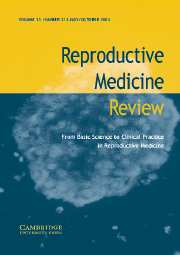Crossref Citations
This article has been cited by the following publications. This list is generated based on data provided by Crossref.
Cooper, Trevor G
1995.
The epididymal influence on sperm maturation.
Reproductive Medicine Review,
Vol. 4,
Issue. 3,
p.
141.
Cooper, Trevor G
1995.
The epididymal influence on sperm maturation.
Reproductive Medicine Review,
Vol. 4,
Issue. 3,
p.
141.
BjöRndahl, Lars
Tomlinson, Mathew
and
Barratt, Christopher L. R.
2004.
Raising Standards in Semen Analysis: Professional and Personal Responsibility.
Journal of Andrology,
Vol. 25,
Issue. 6,
p.
862.
2010.
A Practical Guide to Basic Laboratory Andrology.
p.
227.
2010.
A Practical Guide to Basic Laboratory Andrology.
p.
33.
Björndahl, Lars
2010.
The usefulness and significance of assessing rapidly progressive spermatozoa.
Asian Journal of Andrology,
Vol. 12,
Issue. 1,
p.
33.
Björndahl, Lars
2010.
Reproductive Endocrinology and Infertility.
p.
379.
Mortimer, David
and
Mortimer, Sharon T.
2013.
Spermatogenesis.
Vol. 927,
Issue. ,
p.
61.
Nath, Sushmita
Dutta Choudhury, Manabendra
Roychoudhury, Shubhadeep
Talukdar, Anupam Das
and
Misro, Man Mohan
2013.
Male contraceptive efficacy of Ricinus communis L. extract.
Journal of Ethnopharmacology,
Vol. 149,
Issue. 1,
p.
328.
Jiang, T.
Qin, Y.
Ye, T.
Wang, Y.
Pan, J.
Zhu, Y.
Duan, L.
Li, K.
and
Teng, X.
2014.
Correlation analysis of the progesterone-induced sperm acrosome reaction rate and the fertilisation ratein vitro.
Andrologia,
p.
n/a.
Nordhoff, Verena
Mallidis, Con
and
Kliesch, Sabine
2014.
A Practical Guide to Selecting Gametes and Embryos.
p.
1.
Björndahl, L.
2016.
Compliance with recommendations for reliable semen analysis results - a matter of importance for patients and scientific development.
Andrology,
Vol. 4,
Issue. 5,
p.
771.
Srivastava, N.
Pande, Megha
Tyagi, S.
and
Din, Omer
2017.
Protocols in Semen Biology (Comparing Assays).
p.
7.
2017.
Principles of IVF Laboratory Practice.
p.
97.
Srivastava, N.
and
Pande, Megha
2017.
Protocols in Semen Biology (Comparing Assays).
p.
43.
Björndahl, Lars
2021.
XIIIth International Symposium on Spermatology.
p.
323.
Sharma, Rakesh Kumar
Gupta, Sajal
Agarwal, Ashok
Finelli, Renata
Kuroda, Shinnosuke
Saleh, Ramadan
Boitrelle, Florence
Kavoussi, Parviz
Gül, Murat
Tadros, Nicholas
Ko, Edmund
Farkouh, Ala’a
Henkel, Ralf
Arafa, Mohamed
Rambhatla, Amarnath
and
Shah, Rupin
2022.
Role of Cytocentrifugation Combined with Nuclear Fast Picroindigocarmine Staining in Detecting Cryptozoospermia in Men Diagnosed with Azoospermia.
The World Journal of Men's Health,
Vol. 40,
Issue. 4,
p.
627.
2022.
A Practical Guide to Basic Laboratory Andrology.
p.
34.
2022.
A Practical Guide to Basic Laboratory Andrology.
p.
262.
Björndahl, Lars
2023.
Men's Reproductive and Sexual Health Throughout the Lifespan.
p.
159.


